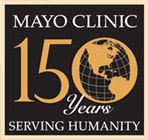Mayo Clinic History
Mayo Clinic developed gradually from the medical practice of a pioneer doctor, Dr. William Worrall Mayo, who settled in Rochester, Minn., in 1863. His dedication to medicine became a family tradition when his sons, Drs. William James Mayo and Charles Horace Mayo, joined his practice in 1883 and 1888, respectively.
From the beginning, innovation was their standard and they shared a pioneering zeal for medicine. As the demand for their services increased, they asked other doctors and basic science researchers to join them in the world's first private integrated group practice.
Although the Mayo doctors were initially viewed as unconventional for practicing medicine through this teamwork approach, the benefits of a private group practice were undeniable.
As the success of their method of practice became evident, so did its acceptance. Patients discovered the advantages to a "pooled resource" of knowledge and skills among doctors. In fact, the group practice concept that the Mayo family originated has influenced the structure and function of medical practice throughout the world.
Along with its recognition as a model for integrated group practice, "the Mayos' Clinic" developed a reputation for excellence in individual patient care. Doctors and students came from around the world to learn new techniques from the Mayo doctors, and patients came from around the world for diagnosis and treatment. What attracted them was not only technologically advanced medicine, but also the caring attitude of the doctors.
Through the years, Mayo Clinic has nurtured and developed its founders' style of working together as a team. Shared responsibility and consensus still provide the framework for decision making at Mayo.
That teamwork in medicine is carried out today by more than 55,000 doctors, nurses, scientists, students and allied health staff at Mayo Clinic locations in the Midwest, Arizona and Florida.


Great work for vitiligo cover up waterproof
ReplyDeleteYou are doing great
ReplyDeleteit was a great, find out about Google Classroom App Download Free For Android
ReplyDeleteFacebook free use
Is Da-video.xyz Legit or not
Ki-Video.Xyz Review